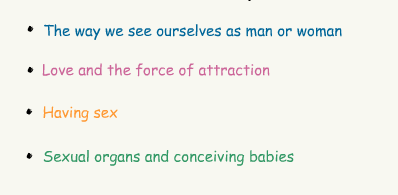- SELF STUDY MODULES
- 1. Intro to TBI
- 2. Communication
- 3. Skills for independence
- 4. Cognitive changes
- 5. Behaviour changes
- 6. Sexuality
- 7. Case management (BIR)
- 8. No longer available
- 9. Mobility & motor control
- 10. Mental health & TBI:
an introduction - 11. Mental health problems
and TBI: diagnosis
& management - 12. Working with Families
after Traumatic Injury:
An Introduction - 13. Goal setting
6.1a What is sexuality?

Check your answers here

Sexuality is an important area of life. Sexual problems are common after traumatic brain injury and so it is important to have information about this.
Sexuality is an area of our lives that is not always talked about. Some people feel too embarrassed to talk with staff about a sexual issue. Sometimes staff do not provide information about sexual problems that may occur after a traumatic brain injury. People with disabilities have sexual feelings and needs. They have the same right as anyone else to enjoy their sexuality.
Definitions
Sexuality is a central aspect of being human throughout life and encompasses sex, gender identities and roles, sexual orientation, eroticism, pleasure, intimacy and reproduction. Sexuality is experienced and expressed in thoughts, fantasies, desires, beliefs, attitudes, values, behaviours, practices, roles and relationships. While sexuality can include all of these dimensions, not all of them are always experienced or expressed. Sexuality is influenced by the interaction of biological, psychological, social, economic, political, cultural, ethical, legal, historical, religious and spiritual factors. (World Health Organisation, 2002)
The definition of sexual concerns needs to be broad, including areas such as sexual rights and responsibilities, gay and lesbian issues, the right to not be sexual if so desired, self-pleasuring (e.g. masturbation), meeting people and establishing relationships (e.g. self-esteem, self confidence, communication, social skills), keeping safe from sexual abuse/exploitation, adjusting the sexual relationship with an existing partner (e.g. loss of intimacy/relationship quality, reduced frequency, problems with communication, loss of social skills), accommodating physical disabilities, assessing and treating sexual dysfunction (e.g. erectile difficulties, orgasmic problems), sexual harassment and inappropriate sexual behaviour, safer sex, issues related to accessing sex workers, fertility, contraception, and pregnancy. (Simpson, 2001, p.99)
